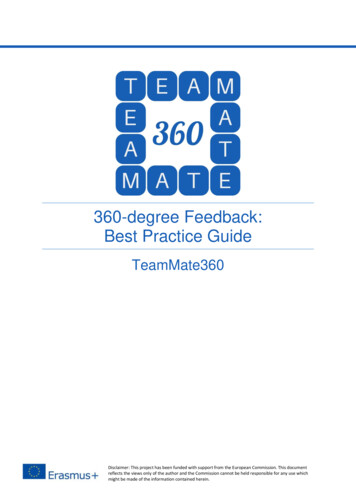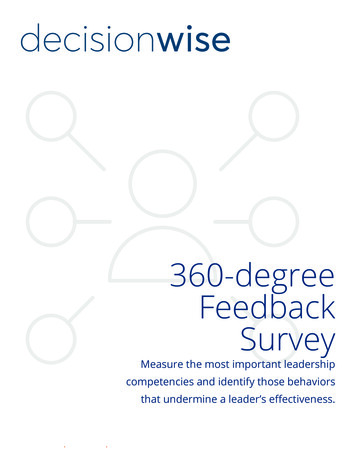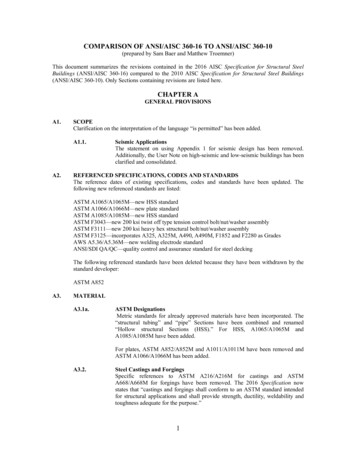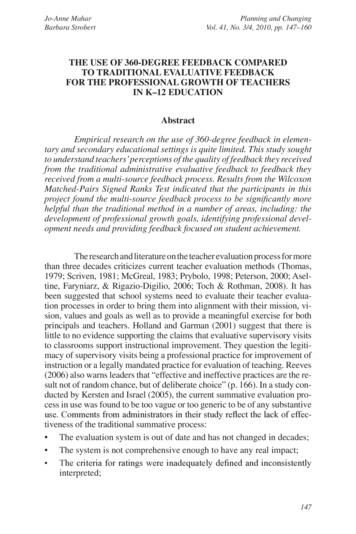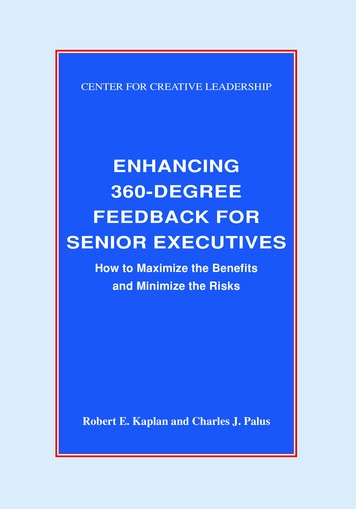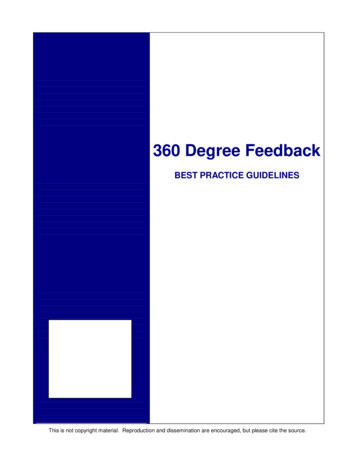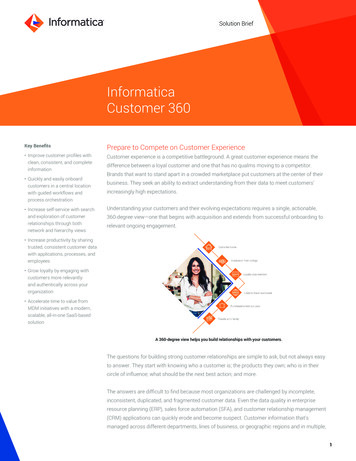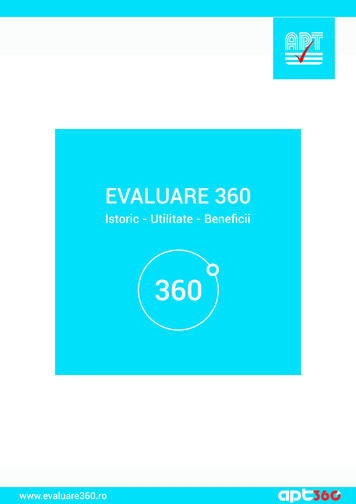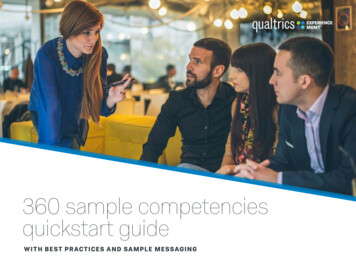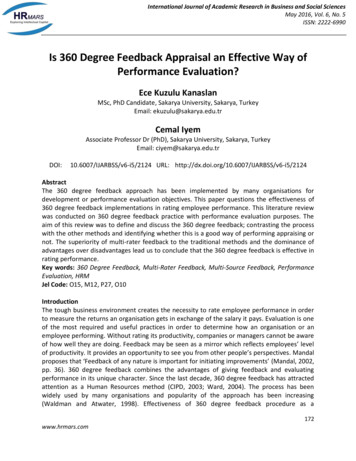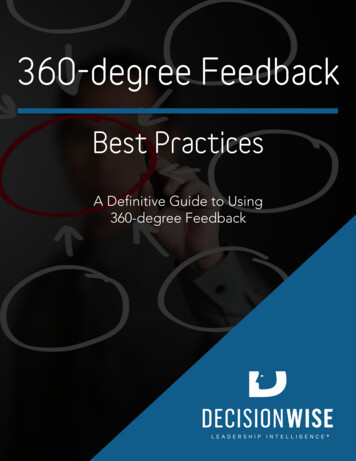
Transcription
360-degree FeedbackBest PracticesA Definitive Guide to Using360-degree Feedback
360-degree feedback best practicesWe’ve been conducting 360-degree feedback surveys andcoaching on the results for a long time—since 1996, to beexact. During this time we’ve figured out the best methods forusing 360 surveys to get the biggest bang for your buck whileavoiding the most common pitfalls.This white paper provides start-to-finish advice fororganizations that are looking to implement the process as wellas those that have conducted 360 surveys for many years.The information is organized based on 12 of the most commonquestions asked by our clients:1. How does 360-degree feedback benefit a leader?2. What should be measured?3. How do you evaluate leadership derailers?4. Which rating scale works best?5. What is the best way to collect qualitative data?6. How should raters be selected?7. Do I need to take my own 360 survey?8. How do raters provide helpful feedback?9. How can the feedback process be kept confidential?10. Who should see the 360 feedback report?11. What is the most effective coaching process?12. What is the best way to follow up with raters?
How does 360-degree feedback benefit a leader?Some leaders question the idea of conducting a formal 360degree feedback process. They might say, “If I want feedbackfrom others, why wouldn’t I just ask them? The problem is thatmost leaders don’t ask for feedback that they need; if they did,people would not be as candid or comprehensive in theirfeedback as they can by using a 360 survey. Multi-raterassessments provide a safe way for others to provide openand honest feedback across a broad spectrum of leadershipcompetencies and behaviors. They reduce the emotional andpolitical barriers that people feel to provide constructiveinformation to a boss or peer.Sometimes the fear of the unknown intimidates people whowant to begin the process. They ask, “What if people use the360-feedback process to get back at me?” The truth is, peopledo not use the feedback process maliciously. On the contrary,they understand that by providing feedback they are investingin the leader’s development and are more willing to providesupport.
What should be measured?Well-structured 360 surveys are best used to measure againstspecific leadership competencies and behaviors that arecritical to an individual’s success (or failure). Most surveysinclude 8-12 competency areas that include a total of 60-80specific behavior statements to rate.We also recommend using a short section to evaluateleadership derailers, which are negative behaviors that aredetrimental to leadership success. Read through the surveyitems to make sure they are relevant to the leaders in yourorganization.That said, organizations often arrive at an interestingcrossroads: the decision to use a standard 360 survey or tocustomize a survey based on the organization’s specificleadership competencies. Custom 360 surveys are recommended fororganizations that already have leadershipcompetencies in place and want to provide feedbackto all leaders in the organization. Multiple versions ofthe 360 survey can be developed for different levelsof leaders (executives to team leaders). This optionwill cost more, but it will provide a relevant tool thatcan be used for years to come. Standard 360 surveys are great because they havebeen tested and validated, provide benchmarkcomparisons, and typically measure a broad range ofleadership competencies. Because they don’t requirea customization fee, a standard survey is a goodoption for small groups or for organizations with noformal competency model in place.
What about leadership derailers?A derailer is a behavior that gets in the way of optimal results.A derailer is not just a weakness. We all have manyweaknesses that we may not need to develop to succeed. Aderailer is a weakness that requires improvement if we are torealize our full potential. Some examples of leadershipderailers include the following: Not a team player: Selfish; places personal agendabefore the good of the team. Not trusted: Violates or compromises the trust ofothers; has difficulty gaining the trust of others. Micromanager: Overly controlling; does notempower others with the freedom and latitude to dotheir best work.We recommend using a set of 10-12 derailers as a separatesection of the survey because the statements are negativelyworded and the rating scale is different. The derailer sectionhelps to identify bad behaviors that may not appear in theother competency areas. It also helps to identify patterns inthe feedback. For example, if leaders show an inclination tomicromanage or towards perfectionism, they tend to alsoscore high on results orientation or planning and organization.
Which rating scale works best?We recommend using a seven-point Likert rating scale on 360degree feedback surveys. Why? Because a seven-point scaleprovides a wider range of responses, making it easier to seegaps in perception between rater groups.What is the best way to collect qualitative data?We recommend using two or three open-ended questions atthe end of the survey to gather comments. Since each openended question adds another two minutes to the survey’scompletion time, more than three tends to lead to rater fatigueand survey abandonment.We’ve found that two or three open-ended questions stillprovide abundant feedback and help provide clarification to thequantitative responses. Here are two questions that we like touse:1. Describe this person’s greatest strengths as a leader.2. Describe specific things this person could do tobecome a more effective leader.
How should raters be selected?We recommend that the participant (the one receiving thefeedback) be involved in deciding who will be asked to take thesurvey. This allows the person to feel more invested in theprocess and accepting of the results. Ideally, the participantmeets with his or her manager to come up with a list of raterswith the manager providing final approval. If the participant isnot involved when selecting raters, they are more likely todiscount the results of the survey.We recommend selecting between 8 and 15 raters, with aminimum of 3 in each rater group. Rater groups typicallyinclude the following: Direct manager (boss)SelfDirect reportsPeersOtherBe sure to include all direct reports, even if this is a largegroup. This way, no one feels excluded from the process.
Do I need to take my own 360 survey?Yes, please! Unless you take your own survey, you can’tcompare your self-perceptions to those of others. Seeingdiscrepancies between how your supervisors, peers, and directreports see you versus how you see yourself it he most eyeopening and developmental aspect of 360-degree feedback.How do raters provide helpful feedback?Raters (those providing feedback) should always receive someinstruction on how to give good feedback. This helps to easeany concerns about the process and ensure that the feedbackis constructive and helpful for the participant. Feedback shouldbe relevant and actionable. When preparing raters to providefeedback, ask them to do the following: Be respectfulSpeak for themselvesAnswer only the questions being askedAlso make clear that their responses are confidential and areaveraged together as a group. No individual scores will beshown on the report except for those provided by the managerand the participant.
How can the feedback process be kept confidential?Confidentiality is the most important part of the 360-degreefeedback process. In order to collect honest and candidfeedback, raters need to be assured that their feedback will bekept anonymous. Here are the best ways to maintainconfidentiality: Set expectations: Communicate about the process,who will participate, and who will see the results. Outsource the process: If you run the 360 processinternally using an online software tool, employeesare more likely to believe that their responses can beseen by HR or their manager. Select enough raters: Make sure that you haveenough raters in each rater group to provide anaggregate score. We recommend at least tworesponses per rater group to show results. Thatmeans each group should have at least three raters,in case one person does not respond.
Who should see the 360 feedback report (besides theparticipant)?If you are using 360-degree feedback in your organization forthe first time, we recommend that the individual report beprovided to only the participant and a coach (internal orexternal). This will help quall any fears about confidentialityand the results being used in a punitive way.To ensure accountability, set expectations that the participantwill need to talk with his or her boss about the action plan thatthey will create as a result of the process. In future years,inform everyone involved if you will share the individual reportwith the boss or others in HR.What is the most effective coaching process?We can’t stress the importance of coaching on 360 feedbackenough. Our research shows that 94 percent of those thatreceive coaching and set goals feel that the feedback processis effective. Conversely, only 34 percent feel the process iseffective if they don’t receive any coaching.Ideally, the participant should meet for about 90 minutes withan internal or external coach to review the results and create apersonal action plan. This ensures that the feedback isinterpreted correctly and the participant has an accountabilitypartner with whom to discuss ideas. This coach can help theperson process emotions and gain clarity on how they areperceived by others.
What is the best way to follow up with raters?When others give feedback using a 360-degree survey, theybecome involved in the participant’s process of improvement.They invest time, energy, and thought into the feedback theyprovide. That’s why it is important for the participant to thankraters for their feedback, acknowledge what is working andwhat is not working, and ask for their help in reachingdevelopment goals.Raters are more likely to continue to support the person’sdevelopment when they are personally asked to participate,they see that the person acts on their feedback, and the personfollows through with them afterwards on his or hercommitments.Final thoughtsHonest and reliable feedback is necessary to test one’s ownperceptions, recognize previously unseen strengths, andbecome aware of blind spots in one’s self-perceptions. Thisnew self-awareness acts as a catalyst to promote personaldevelopment and change. The outcome of the process is tocreate a personal development action plan.Bottom line, 360-degree feedback is the best way to start apersonal development journey, change habits, improverelationships with others, and become a better leader.
Questions about 360-degreefeedback? Contact us for a freeconsultation. 1.801.960.1400www.decision-wise.comCopyright 2014 DecisionWise,Inc. All rights reserved.
360-degree feedback best practices We've been conducting 360-degree feedback surveys and coaching on the results for a long time—since 1996, to be exact. During this time we've figured out the best methods for using 360 surveys to get the biggest bang for your buck while avoiding the most common pitfalls.
